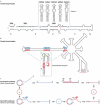Viroids: an Ariadne's thread into the RNA labyrinth
- PMID: 16741503
- PMCID: PMC1479586
- DOI: 10.1038/sj.embor.7400706
Viroids: an Ariadne's thread into the RNA labyrinth
Abstract
Viroids are structurally, functionally and evolutionarily different from viruses. Despite their small, non-protein-encoding, single-stranded circular RNA genome, viroids can infect higher plants and cause certain diseases. Members of the two viroid families, Pospiviroidae and Avsunviroidae, have evolved to usurp the transcriptional machinery of their host nuclei and chloroplasts, respectively, in which replication proceeds through a rolling-circle mechanism involving RNA polymerization, cleavage and ligation. Remarkably, viroids subvert certain DNA-dependent RNA polymerases to transcribe RNA templates, and, in the family Avsunviroidae, post-transcriptional cleavage is catalysed by hammerhead ribozymes. Viroids are models for studying RNA evolution and for analysing RNA transport in plants, because they can move intracellularly, intercellularly through plasmodesmata and to distal parts of the plant through the vascular system. Viroids elicit RNA-silencing phenomena, which might mediate some of their biological properties, including pathogenesis. As some viroids behave as catalytic RNAs, they are regarded as remnants of the RNA world.
Figures


Similar articles
-
Viroids: the minimal non-coding RNAs with autonomous replication.FEBS Lett. 2004 Jun 1;567(1):42-8. doi: 10.1016/j.febslet.2004.03.118. FEBS Lett. 2004. PMID: 15165891 Review.
-
Viroids: unusual small pathogenic RNAs.Acta Biochim Pol. 2004;51(3):587-607. Acta Biochim Pol. 2004. PMID: 15448723 Review.
-
Viroids and viroid-host interactions.Annu Rev Phytopathol. 2005;43:117-39. doi: 10.1146/annurev.phyto.43.040204.140243. Annu Rev Phytopathol. 2005. PMID: 16078879 Review.
-
A naked plant-specific RNA ten-fold smaller than the smallest known viral RNA: the viroid.C R Acad Sci III. 2001 Oct;324(10):943-52. doi: 10.1016/s0764-4469(01)01370-1. C R Acad Sci III. 2001. PMID: 11570283 Review.
-
ICTV Virus Taxonomy Profile: Avsunviroidae.J Gen Virol. 2018 May;99(5):611-612. doi: 10.1099/jgv.0.001045. Epub 2018 Mar 26. J Gen Virol. 2018. PMID: 29580320
Cited by
-
Deep sequencing of viroid-derived small RNAs from grapevine provides new insights on the role of RNA silencing in plant-viroid interaction.PLoS One. 2009 Nov 5;4(11):e7686. doi: 10.1371/journal.pone.0007686. PLoS One. 2009. PMID: 19890399 Free PMC article.
-
ViroidDB: a database of viroids and viroid-like circular RNAs.Nucleic Acids Res. 2022 Jan 7;50(D1):D432-D438. doi: 10.1093/nar/gkab974. Nucleic Acids Res. 2022. PMID: 34751403 Free PMC article.
-
Construction of Infectious cDNA Clone of a Chrysanthemum stunt viroid Korean Isolate.Plant Pathol J. 2014 Mar;30(1):68-74. doi: 10.5423/PPJ.OA.08.2013.0076. Plant Pathol J. 2014. PMID: 25288987 Free PMC article.
-
Diversity and evolution of viroids and viroid-like agents with circular RNA genomes revealed by metatranscriptome mining.Nucleic Acids Res. 2025 Jan 24;53(3):gkae1278. doi: 10.1093/nar/gkae1278. Nucleic Acids Res. 2025. PMID: 39727156 Free PMC article.
-
Can plant viruses cross the kingdom border and be pathogenic to humans?Viruses. 2015 Apr 20;7(4):2074-98. doi: 10.3390/v7042074. Viruses. 2015. PMID: 25903834 Free PMC article. Review.
References
Publication types
MeSH terms
Substances
LinkOut - more resources
Full Text Sources
Other Literature Sources
Research Materials

